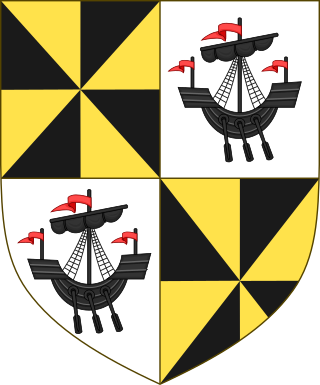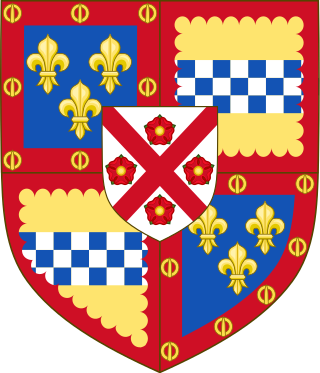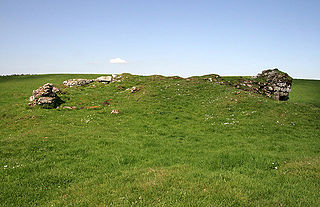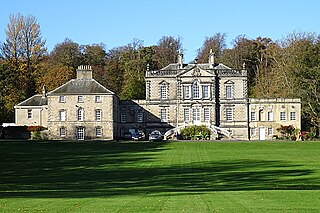Related Research Articles
James Hamilton, 1st Earl of AbercornPC (S) (1575–1618), was a Scottish diplomat for James VI and an undertaker in the Plantation of Ulster in the north of Ireland.

Colin Campbell, 1st Earl of Argyll was a medieval Scottish nobleman, peer, and politician. He was the son of Archibald Campbell, Master of Campbell and Elizabeth Somerville, daughter of John Somerville, 3rd Lord Somerville. He had the sobriquet Colin Mulle, Bold Earl Colin.

Gillespie Archibald Campbell, 2nd Earl of Argyll was a Scottish nobleman and politician who was killed at the Battle of Flodden.
Thomas Boyd, Earl of Arran was a Scottish nobleman.
Robert Boyd, 1st Lord Boyd was a Scottish statesman, Lord Chamberlain of Scotland from 1467.
Robert Boyd, 4th Lord Boyd was a Scottish nobleman who supported various factions attempting to dominate Scottish politics during the reign of King James V and the minority of Mary, Queen of Scots.
Robert Boyd, 5th Lord Boyd was a Scottish noble and courtier.

Sir James Hamilton of Finnart was a Scottish nobleman and architect, the illegitimate son of James Hamilton, 1st Earl of Arran, and Marion Boyd of Bonshaw. Although legitimated in 1512 while still a minor, he continued to be known as the "Bastard of Arran". As a key member of the Hamilton family, and second cousin of James V, King of Scotland, he became a prominent member of Scottish society.

Lord Somerville is a title in the Peerage of Scotland which is subject to a number of ambiguities. The date of creation is not known with certainty but it was probably created about 1435 for Thomas Somerville, Justiciar of Scotland. The title was omitted in 1606 when an ordered list of the Scottish peerage was produced following the union of the Scottish and English crowns, and the title was not used during the 17th century. In 1723, however, the House of Lords ratified and acknowledged the title for James Somerville the 13th Lord. The consecutive numbers ascribed to the numerous Lords differ according to which authority is consulted. The list below uses the numbers favoured by Burkes Peerage.

John Stewart, 1st Earl of Lennox was a Scottish earl. He was known as Lord Darnley and later as the Earl of Lennox.
William Somerville, 2nd Lord Somerville was a member of the Scottish Parliament in the mid-15th century. He is the first person to have clearly held the title Lord Somerville, having been created such in 1445, although other sources suggest that his father was the first Lord.
John Ross, 1st Lord Ross of Halkhead was a Scottish nobleman.
Hugh Somerville, 5th Lord Somerville was a lord of the Parliament of Scotland. He is sometimes reckoned to be the 4th Lord Somerville. He succeeded his brother, John Somerville, 4th Lord Somerville. Hugh and John were sons of William Somerville, Master of Somerville, and Marjory Montgomerie.
John Somerville, 4th Lord Somerville, (c.1484-1523), was a Lord of the Parliament of Scotland.

Cowthally Castle, also known as Couthalley, is a ruined L-plan castle near Carnwath, Lanarkshire, Scotland. The remains are protected as a scheduled monument.
Thomas Somerville, 1st Lord Somerville,, was a Lord of the Parliament of Scotland.

The Drum is an 18th-century country house and estate on the outskirts of Edinburgh, Scotland. Located between the Gilmerton and Danderhall areas, The Drum is 4 miles (6.4 km) south-east of the city centre. The Drum was the seat of the Lords Somerville from the later Middle Ages, who built a 16th-century house on the estate. This was replaced in the 1720s with a classical house by William Adam. Sold by Lord Somerville in the early 19th century, the house remains in private hands.
James Wood was a Covenanter and Church of Scotland minister. He was appointed to be Professor of Divinity and Principal of the Old College, St. Andrews by Cromwell's government. He was deposed after the Restoration under the influence of Archbishop Sharp in 1663. He was then holding Presbyterian principles at a time when Charles II was promoting Prelacy. He died in 1664.
Hugh Montgomerie, 4th Earl of Eglinton (1563–1586) was a Scottish landowner.

Baron of Gilmerton is a title of nobility in the Baronage of Scotland in the county of Midlothian. It was created in 1667 for Sir John Baird of Newbyth, Lord Newbyth.
References
- ↑ MacDougall, Norman, James III: a political study, John Donald (1982), 72-79.
- ↑ MacDougall, Norman, James III: a political study, John Donald (1982), 80-82.
- ↑ Memorie of the Somervilles, vol.1, (1815), 270 & fn, 297-299.
- ↑ Accounts of the Lord High Treasurer of High Treasurer of Scotland, vol. 1 (1877), 119-121.
- ↑ Acts of the Lords Auditors of Causes and Complaints, 1466-1494, (1839), 155, 165.